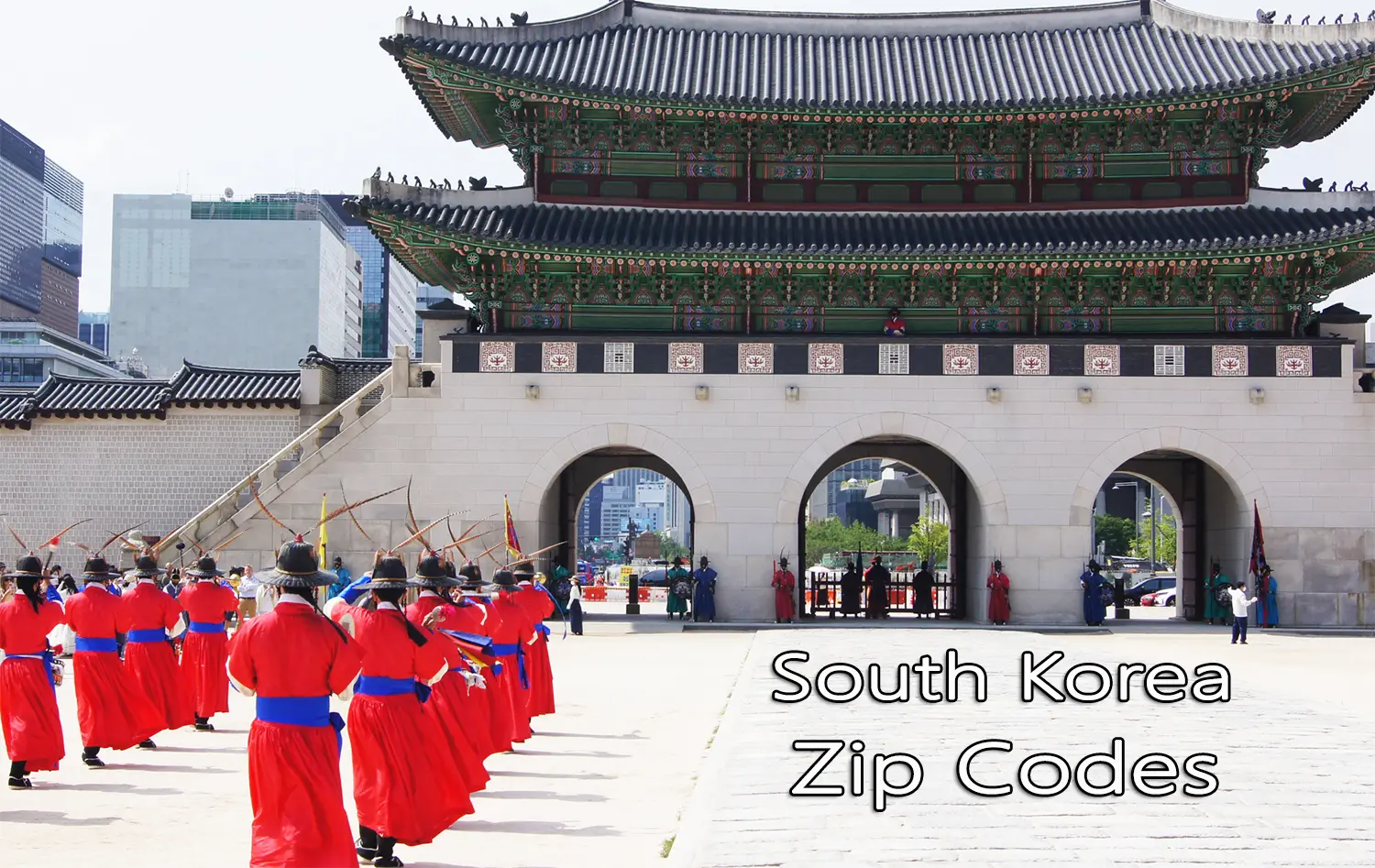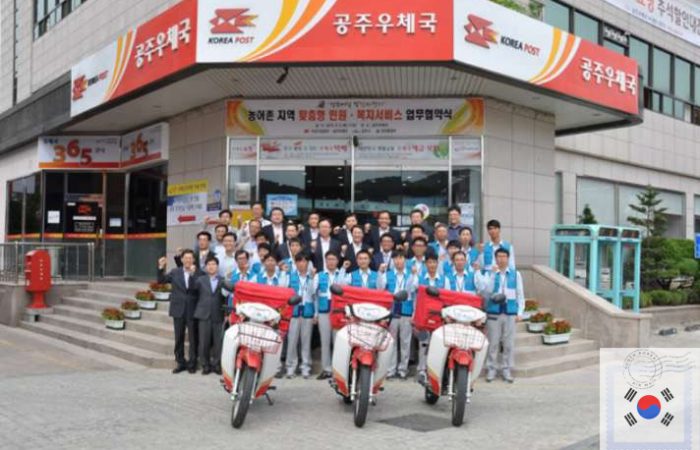In South Korea, The postal code consists of a 5-digit number, and it is used to identify specific regions, districts, and buildings for the purpose of efficient mail delivery. first two digit represent the Special (Metropolitan) City/Province. The third digit indicates a specific district within the administrative unit. The fourth and fifth digits denote a specific post office or a specific building or group of buildings within the district. Postal service provider in South Korea is called “Korea Post,” operated by the Ministry of Science and ICT.

Postal codes in South Korea are composed of five digits. A new system of post codes was introduced on August 1, 2015. The first postal code in South Korea was established on July 1, 1970, and has been revised three times: in 1988, 2000, and 2015.
History of South Korea Postal Codes
From 1970-1988
South Korea’s first postal code was introduced on July 1, 1970. Individual codes were provided for each post office distribution area, using an nnn-nn numeric format (e.g., 120-01 represented Susaek-dong, Seodaemun-gu, Seoul). Unlike current postal coding provided by administrative districts, the 1970 system was implemented based upon a post office’s railroad line; this often led to inconsistencies in post codes relative to their administrative areas.
Large post offices used a three-digit postal code, and small offices a five-digit code
From 1988-2000
Postal codes became six digits long on February 1, 1988. They were grouped by administrative areas as reflected by district reorganization and highway transportation networks.
These codes utilized an nnn-nnn format; the first three digits represented, in order, the metropolitan administrative district (large city, metropolitan area, province, special autonomous area, etc.), the resident’s neighborhood or ward, and a specific city, county, or district.
The last three digits matched the code to the recipient. They were assigned based on a postman’s delivery route. These sub-codes were divided into statutory dongs and administrative dongs, followed by myeons, and then by buildings and/or mailboxes.
From 2000-2015
On May 1, 2000, postal codes were assigned to each delivery agent’s postal area to facilitate easier distribution. This system relied upon the codes assigned in 1988. New postal codes were subdivided to match each postman’s delivery area, taking into account the introduction of automated mail sorting equipment.
Current System
The six-digit postal code was abolished on August 1, 2015, to be replaced with the current five-digit system that uses a simpler nnnnn format.

How to Find Your Zip Code in Korea
Getting your head around the Korean address system might be a pain in the neck. If you have been living in Korea for a few years, you might have noticed the change of the address system, which is now based on specific street names and building numbers in your neighborhood. Zip code is an important part of the Korean address system, and that’s why Expat Guide Korea prepared a guide on how to find your zip code in Korea.
Korean Zip Code
Zip codes or postal codes are specific identification numbers given to the specific neighborhood in which your place is located. Starting from 2015, 5-digit numbers are used as zip codes in Korea, replacing the old 6-digit zip codes.
The 5-digit district number assigned based on the geographic features (roads, rivers, railroads, etc.) and assigned to each State Basic District will replace the existing 6-digit postal code created based on the administrative units (Eup, Myeon and Dong) and the districts assigned to each postman.
| List of All Postal Codes in Seoul | |
| County | Postal Codes |
| Gangbuk-gu | 01000 – 01237 |
| Dobong-gu | 01300 – 01489 |
| Nowon-gu | 01600 – 01914 |
| Jungnang-gu | 02000 – 02263 |
| Dongdaemun-gu | 02400 – 02646 |
| Seongbuk-gu | 02700 – 02880 |
| Jongno-gu | 03000 – 03198 |
| Eunpyeong-gu | 03300 – 03506 |
| Seodaemun-gu | 03600 – 03789 |
| Mapo-gu | 03900 – 04214 |
| Yongsan-gu | 04300 – 04428 |
| Jung-gu | 04500 – 04637 |
| Seongdong-gu | 04700 – 04809 |
| Gwangjin-gu | 04900 – 05413 |
| Songpa-gu | 05500 – 05857 |
| Gangnam-gu | 06000 – 06378 |
| Seocho-gu | 06500 – 06806 |
| Dongjak-gu | 06900 – 07074 |
| Yeongdeungpo-gu | 07200 – 07448 |
| Gangseo-gu | 07500 – 07813 |
| Yangcheon-gu | 07900 – 08111 |
| Guro-gu | 08200 – 08395 |
| Geumcheon-gu | 08500 – 08657 |
| Gwanak-gu | 08700 – 08866 |
| List of All Postal Codes in Busan | |
| Gijang-gun | 46000 – 46082 |
| Geumjeong-gu | 46200 – 46335 |
| Buk-gu | 46500 – 46653 |
| Gangseo-gu | 46700 – 46771 |
| Sasang-gu | 46900 – 47055 |
| Busanjin-gu | 47100 – 47397 |
| Yeonje-gu | 47500 – 47616 |
| Dongnae-gu | 47700 – 47906 |
| Haeundae-gu | 48000 – 48120 |
| Suyeong-gu | 48200 – 48318 |
| Nam-gu | 48400 – 48595 |
| Dong-gu | 48700 – 48822 |
| Jung-gu | 48900 – 48984 |
| Yeongdo-gu | 49000 – 49128 |
| Seo-gu | 49200 – 49277 |
| Saha-gu | 49300 – 49528 |
| List of All Postal Codes in Chungcheongnam-do | |
| Cheonan-si | 31000 – 31261 |
| Asan-si | 31400 – 31584 |
| Dangjin-si | 31700 – 31817 |
| Seosan-si | 31900 – 32030 |
| Taean-gun | 32100 – 32172 |
| Hongseong-gun | 32200 – 32299 |
| Yesan-gun | 32400 – 32457 |
| Gongju-si | 32500 – 32626 |
| Geumsan-gun | 32700 – 32762 |
| Gyeryong-si | 32800 – 32842 |
| Nonsan-si | 32900 – 33028 |
| Buyeo-gun | 33100 – 33232 |
| Cheongyang-gun | 33300 – 33368 |
| Boryeong-si | 33400 – 33522 |
| Seocheon-gun | 33600 – 33677 |
| List of All Postal Codes in Daegu | |
| Dong-gu | 41000 – 41269 |
| Buk-gu | 41400 – 41599 |
| Seo-gu | 41700 – 41872 |
| Jung-gu | 41900 – 41978 |
| Suseong-gu | 42000 – 42288 |
| Nam-gu | 42400 – 42515 |
| Dalseo-gu | 42600 – 42842 |
| Dalseong-gun | 42900 – 43024 |
| List of All Postal Codes in Daejeon | |
| Yuseong-gu | 34000 – 34232 |
| Daedeok-gu | 34300 – 34445 |
| Dong-gu | 34500 – 34712 |
| Jung-gu | 34800 – 35086 |
| Seo-gu | 35200 – 35428 |
| List of All Postal Codes in Gangwon-do | |
| Cheorwon-gun | 24000 – 24067 |
| Hwacheon-gun | 24100 – 24161 |
| Chuncheon-si | 24200 – 24471 |
| Yanggu-gun | 24500 – 24564 |
| Inje-gun | 24600 – 24668 |
| Goseong-gun | 24700 – 24770 |
| Sokcho-si | 24800 – 24904 |
| Yangyang-gun | 25000 – 25061 |
| Hongcheon-gun | 25100 – 25273 |
| Pyeongchang-gun | 25300 – 25384 |
| Gangneung-si | 25400 – 25646 |
| Donghae-si | 25700 – 25822 |
| Samcheok-si | 25900 – 25961 |
| Taebaek-si | 26000 – 26053 |
| Jeongseon-gun | 26100 – 26157 |
| Yeongwol-gun | 26200 – 26248 |
| Wonju-si | 26300 – 26509 |
| List of All Postal Codes in Gwangju | |
| Buk-gu | 61000 – 61273 |
| Dong-gu | 61400 – 61514 |
| Nam-gu | 61600 – 61768 |
| Seo-gu | 61900 – 62078 |
| Gwangsan-gu | 62200 – 62466 |
| List of All Postal Codes in Gyeonggi-do | |
| Gimpo-si | 10000 – 10136 |
| Goyang-si | 10200 – 10599 |
| Paju-si | 10800 – 10955 |
| Yeoncheon-gun | 11000 – 11050 |
| Pocheon-si | 11100 – 11192 |
| Dongducheon-si | 11300 – 11366 |
| Yangju-si | 11400 – 11525 |
| Uijeongbu-si | 11600 – 11816 |
| Guri-si | 11900 – 11962 |
| Namyangju-si | 12000 – 12285 |
| Gapyeong-gun | 12400 – 12473 |
| Yangpyeong-gun | 12500 – 12585 |
| Yeoju-si | 12600 – 12668 |
| Gwangju-si | 12700 – 12819 |
| Hanam-si | 12900 – 13029 |
| Seongnam-si | 13100 – 13647 |
| Gwacheon-si | 13800 – 13841 |
| Anyang-si | 13900 – 14128 |
| Gwangmyeong-si | 14200 – 14354 |
| Bucheon-si | 14400 – 14790 |
| Siheung-si | 14900 – 15119 |
| Ansan-si | 15200 – 15658 |
| Gunpo-si | 15800 – 15892 |
| Uiwang-si | 16000 – 16109 |
| Suwon-si | 16200 – 16713 |
| Yongin-si | 16800 – 17183 |
| Icheon-si | 17300 – 17424 |
| Anseong-si | 17500 – 17609 |
| Pyeongtaek-si | 17700 – 18001 |
| Osan-si | 18100 – 18151 |
| Hwaseong-si | 18200 – 18635 |
| List of All Postal Codes in Gyeongsangbuk-do | |
| Yeongju-si | 36000 – 36175 |
| Bonghwa-gun | 36200 – 36273 |
| Uljin-gun | 36300 – 36371 |
| Yeongdeok-gun | 36400 – 36564 |
| Andong-si | 36600 – 36760 |
| Yecheon-gun | 36800 – 36867 |
| Mungyeong-si | 36900 – 37003 |
| Sangju-si | 37100 – 37276 |
| Uiseong-gun | 37300 – 37375 |
| Cheongsong-gun | 37400 – 37465 |
| Pohang-si | 37500 – 37948 |
| Gyeongju-si | 38000 – 38221 |
| Cheongdo-gun | 38300 – 38268 |
| Gyeongsan-si | 38400 – 38698 |
| Yeongcheon-si | 38800 – 38913 |
| Gunwi-gun | 39000 – 39066 |
| Gumi-si | 39100 – 39459 |
| Gimcheon-si | 39500 – 39698 |
| Chilgok-gun | 39800 – 39915 |
| Seongju-gun | 40000 – 40066 |
| Goryeong-gun | 40100 – 40166 |
| Ulleung-gun | 40200 – 40240 |
| List of All Postal Codes in Gyeongsangnam-do | |
| Hamyang-gun | 50000 – 50057 |
| Geochang-gun | 50100 – 50153 |
| Hapcheon-gun | 50200 – 50253 |
| Changnyeong-gun | 50300 – 50367 |
| Miryang-si | 50400 – 50467 |
| Yangsan-si | 50500 – 50658 |
| Gimhae-si | 50800 – 51025 |
| Changwon-si | 51100 – 51797 |
| Haman-gun | 52000 – 52073 |
| Uiryeong-gun | 52100 – 52160 |
| Sancheong-gun | 52200 – 52264 |
| Hadong-gun | 52300 – 52355 |
| Namhae-gun | 52400 – 52455 |
| Sacheon-si | 52500 – 52571 |
| Jinju-si | 52600 – 52859 |
| Goseong-gun | 52900 – 52963 |
| Tongyeong-si | 53000 – 53104 |
| Geoje-si | 53200 – 53337 |
| List of All Postal Codes in Incheon | |
| Gyeyang-gu | 21000 – 21129 |
| Bupyeong-gu | 21300 – 21460 |
| Namdong-gu | 21500 – 21700 |
| Yeonsu-gu | 21900 – 22031 |
| Michuhol-gu | 22100 – 22243 |
| Jung-gu | 22300 – 22410 |
| Dong-gu | 22500 – 22575 |
| Seo-gu | 22600 – 22858 |
| Ganghwa-gun | 23000 – 23062 |
| Ongjin-gun | 23100 – 23136 |
| List of All Postal Codes in Jeju-do | |
| Jeju-si | 63000 – 63365 |
| Seogwipo-si | 63500 – 63644 |
| List of All Postal Codes in Jeollabuk-do | |
| Gunsan-si | 54000 – 54179 |
| Gimje-si | 54300 – 54426 |
| Iksan-si | 54500 – 54679 |
| Jeonju-si | 54800 – 55151 |
| Wanju-gun | 55300 – 55368 |
| Jinan-gun | 55400 – 55460 |
| Muju-gun | 55500 – 55563 |
| Jangsu-gun | 55600 – 55662 |
| Namwon-si | 55700 – 55805 |
| Imsil-gun | 55900 – 55957 |
| Sunchang-gun | 56000 – 56059 |
| Jeongeup-si | 56100 – 56216 |
| Buan-gun | 56300 – 56349 |
| Gochang-gun | 56400 – 56469 |
| List of All Postal Codes in Eollanam-do | |
| Yeonggwang-gun | 57000 – 57010 |
| List of All Postal Codes in Sejong | |
| Sejong-si | 30000 – 30154 |
| List of All Postal Codes in Ulsan | |
| Dong-gu | 44000 – 44115 |
| Buk-gu | 44200 – 44264 |
| Jung-gu | 44400 – 44553 |
| Nam-gu | 44600 – 44787 |
| Ulju-gun | 44900 – 45015 |
South Korean Address System
Did you know that South Korea’s address system is different from what most of countries in the world use? If you have seen a written address in South Korea, you’ll be confused at first because of the different format. So, before we learn about Korean Addresses, let us first discover the South Korean address system.
Just a quick fact, in the East Asian System, the administrative divisions characterize a typical building located in South Korea. If the address is written in South Korean, the largest division comes first, followed by the lesser divisions, the building, and lastly, the recipient. If the recipient lives in a multi-story building, include the floor and apartment or suite number.
It’s vital to note that in South Korea, the overall arrangement of addresses is the opposite of how addresses are usually written in Western Countries. If you are used to an address written from the smallest unit down to the province, then you have to know that Korean addresses work differently. The order is reversed instead of commencing with the home number and ending with the postal code. Take a look at the examples below.
Old Korean Address System: land-focused; city, district, neighborhood, land lot number
Example: 서울시 마포구 상수동 24-5번지 seoulsi mapogu sangsudong 24-5beonji – Seoul 24-5, Mapo-gu, Sangsu-dong
New Korean address system: building-focused; city, district, street name, and number
Example: 서울시 마포구 와우산로5안길 54-18 seoulsi mapogu wausanro5angil 54-18 – 54-18, Wausan-ro 5-an-gil, Mapo-gu, Seoul
The change of Korean address from lot-based to street-based happened on the year 2014. In the new system, all streets will have names that end in 대로 (daero, big road,) 길 (gil, road) or 로 (ro, road.) Due to the change from the previous system, buildings were given new building numbers. This gained different reactions from the locals. But, this change made it easy for foreigners to travel around South Korea.
Sending A Post Card In South Korea
You might be thinking, who still rights a postcard in this digital age? Well, it turns out that postcards are still part of Korean culture, especially during holiday seasons. It is used to send greetings to your loved ones. Companies also use postcards to send to their investors, customers, and others. So, do you know what to put in each postcard’s address line? It’s pretty simple:
1. Start with the recipient’s name. (last name – first name – honorifics)
2. Write the province first.
3. Proceed with street name and street number.
4. Include the house number.
5. Add the postal code.



